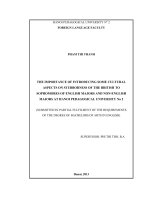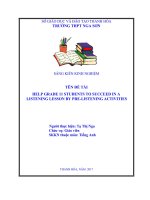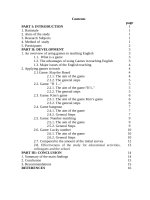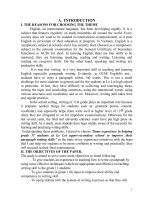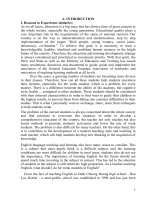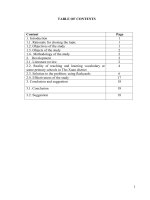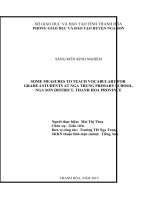Some experiences on guiding grade 4 students to create poems as a technique to help developing english skill
Bạn đang xem bản rút gọn của tài liệu. Xem và tải ngay bản đầy đủ của tài liệu tại đây (138.23 KB, 17 trang )
THE TABLE OF CONTENTS
CONTENT
1. Introduction
1.1. Reason for choosing the topic
1.2. Aim of the study
1.3 The object of the study
1.4. Method of the study
2. Development
2.1. Literature view
2.2. The reality of teaching and learning English in my school.
2.3. Solution for the problem
2.4. What and how to choose to creat a poem?
2.5. Steps to creat a poem.
2.6. Guiding students to present a poem.
2.7. Some activities can be done using poems.
2.8. The effects of the study
3. Conclusion and suggestion
References
1.
PAGE
1
2
2
2
2
3
3
4
5
5
6
9
9
14
15
16
INTRODUCTION
1.1. Reason for choosing the topic
1
These days, our country has been in the integration process and cooperation with many other countries and English is regarded as a global
language in communication. Therefore, we can see the importance of
learning English. For Vietnamese students, who are the future generation of
the country, learning English becomes even more necessary than ever.
English is also mandatory graduation exam levels. But in Vietnam teaching
and learning English are still issues that cause headache education matters
such as how to find a standard method of learning English to help children
progress faster?, why many students who have learnt English for more than
ten years even that after they left school, cannot use the English
competently?, etc. The educational system of Vietnam has taken English as a
compulsory subject at school from primary school years. English in primary
schools is the subject that combines all the skills. It is not too difficult in
term of knowledge but for primary students, the concept of words,
sentences, wording of the mother tongue is vague for them, so they find the
concept of speech, pronunciation, writing, memorizing vocabulary ... of a
foreign language too complex.
I have been a teacher of English for nine years and taken part in many
workshops and courses on teaching English for kids. I always try to find best
ways to make my students interested in learning English and find it easier.
What are difficulties for kids in learning English? In my opinion, they are
remembering words and structures and using them for communicating
naturally. Thanks for many techniques as “rub out and remember”, “what
and where”, “matching” or using songs, chants, so on, kids can remember
words and structures but how to use them to practice in a natural way and
improve the speaking skill effectively? How to help them form and develop
the comprehensive study skills? How to help children love, inculcate
knowledge of foreign culture, grasp and absorb it most effectively? That is
why the research into ways to help school students acquire the full, deep
remembering English vocabulary and using it is quite necessary and
important for primary students. And I would like to introduce my
experienced study that is “Some experiences on guiding grade 4 students
to create poems as a technique to improve the English skills”.
1.2.
Aim of the study
2
The study is carried out to show the benefits of teaching kids how to
use English words and structures to create/write and read simple poems to
help them develop the English skills to gain communicative approach in
teaching and learning English. The rationale behind the package is that
students will have ample opportunities to enrich their English learning
experience and extend a range of language abilities through exploring
poems. Carefully designed and sequenced, the materials and activities in this
package aim to: strengthen students’ skills of understanding and appreciating
the themes, structures, features and language in a range of poem; help
students to respond to and give expression to the imaginative ideas, moods
and feelings expressed in poems and songs through written, oral and
performance means and enable students to apply the knowledge and skills
they have learned in their own creative production and critical appreciation
of poems.
1.3. The object of the study
The grade 4 students are the ones that have a certain number of English
vocabularies, their ways of learning English are formed and they can make
simple English conversations. Vocabularies in English 4 textbook are
various so creating poems give them an opportunity to improve and develop
English skills.
1.4. Method of the study
To obtain the effects of the mentioned aim, I have studied documents from
the methodology course on techniques to teach kids English. Then I read,
analyzed and synthesized the textbook and reference books, made plans on
what to do basing on the grade 4 students’ psychology and language ability.
2. DEVELOPMENT
3
2.1. Literature view
2.1.1 What is a poem?
A poem is a piece of writing in which the words are chosen for their
beauty and sound and carefully arranged, often in short lines in rhyme. Free
verse is a modern form of poetry that does not follow any specific rhyme or
metrical scheme, although it does not completely abandon the basic poetic
precepts of heightened language and sonics. Through poems, people can
show their emotions, feelings, thoughts, looks, etc.
We may have misunderstanding between poems and chants. A chant is
the rhythmic speaking or singing of words or sounds, often primarily on one
or two main pitches called reciting tones. Chants may range from a
simple melody involving a limited set of notes to highly complex musical
structures, often including a great deal of repetition of musical subphrases.
And we often say “Sing chants” but “Read poems”. Rhythm of a poem is
slow and softly strengthened so it is easy to read.
Poetry is characterized by the following:
- Lines
- Syllables
- Rhythm (and beat)
- Rhyme
- Images
- Alliteration
2.1.2. Reasons why creatingEnglish poems should be used in taught and
learnt
There have been positive remarks by scholars who consider poetry an
effective tool for multi-skill development in language learning. According to
Hess (2003), through its drama and emotional context, a good poem is
suitable for a close “reading”, with much good language practice. Hedge
(2000) also believes poems as authentic materials can be used to develop
especially the receptive skill of reading. Another claim is that reproduction
of poetry – memorizing, rewriting, reporting and translating – can exercise
the productive skill of “writing”, which is not an easy task to teach (AlberMorgan Sheila; Hessler, & Konrad, 2007). When considered in terms of the
skill of “speaking”, as the themes of poetry (e.g. love, death, nature, beliefs,
despair etc.) are universal among all human beings (Maley & Duff, 1989),
and because each person’s perception is different, poems can initiate a fund
of interactive discussion and create the atmosphere for a genuine exchange
of ideas. Besides, poetry can also be a very good way to help children
understand the “phonics of English” and work with rhyming words (Collins,
2008). Along with the skills development, the memorability feature of a
poem can support the natural ability to unconsciously absorb language,
which enables the learner to “retrieve grammatical and lexical information”
when needed (Ainy, 2008).
4
Most of Vietnamese people think that creating poems is very difficult
because it is considered as a style of art that requires creation and literature
aesthetic values. In some cases, that is not completely true. Creating simple
poems is very entertaining to deal with while students constantly work on all
skills simultaneously, even though they are not conscious about it
sometimes. Poems’ structure makes them easy to read while its rhyme makes
them extremely memorable. On top of that poems provoke people to express
their personal opinion which is great for working on speaking. In many
countries where English is used as the second language, poetry plays an
important role in teaching four basic language skills like reading, writing,
listening and speaking.
Poems are authentic texts. This is a great motivator. Learning becomes
stimulating and fun. Poems present a wide range of learning opportunities.
Kids can learn the four skills, practice specific language structures,
pronunciation and grammar. Reading poems loud can make significant gains
in students’ oral reading fluency. When writing/ creating poems, kids have
interesting opportunities to express themselves, students can explore their
imagination and ideas when writing poems, and nurture their creativity.
Students develop confidence in sharing ideas. Through listening to/ creating/
reading poems, students can improve their language and skills.
2.2. The reality of teaching and learning English in my school
The school where I am teaching is in a town. People’s lives here are quite
good so most of my students’ families have good conditions of living. The
parents really care of their children’s studies in common and, especially,
their English learning because they now understand that English plays a very
important role in studying and career. More than fifty percent of the students
in my school are excellent and good. They like English very much. Many of
them like learning English as well. They can remember many new words.
They can memorize model or forms of sentences. They can do the tasks of
the lessons in the textbooks. However, I have realized that my students have
passive style of learning. Their memorized words and sentences are not
often used so they will not be able to promote their language skills. During
my periods of teaching English I noticed that my students had many
difficulties in speaking and writing skills. They found it was hard to express
their ideas.
And one more problem is that there are not many creative activities signed
for students in the textbook and at school.
In this school year, we are going to hold English clubs for all the students.
There will games, song and chant performance or many other interesting
activities. This is a chance for them to play to learn and show their ability of
English skills.
5
A servey has been done for my 64 grade 4 students. I gave them some Yes/
No questions about poems and here is the result.
64 grade 4 students
Questions
Yes
1. Have you ever known about English
0
poems?
2. Have you ever read any English poems?
0
3. Have you ever make any poems in
0
Vietnamese or English?
4. Do you think that making and reading
English poems can help you to improve your
level of English in terms of creativity, use of
15
Percent
No
Percent
0
64
100
0
64
100
0
64
100
23,4%
49
76,6%
vocabulary and pronunciation?
The result showed that all the students had no concepts of knowing or
making any poems. And some of them thought poems was able to help them
in learning English.
2.3. Solution to the problem
The reason why I suggest creating poems is because poems are very
entertaining to deal with while students constantly work on all skills
simultaneously, even though they are not conscious about it sometimes.
Poems’ structure makes them easy to read while its rhyme makes them
extremely memorable. On top of that poems provoke people to express their
personal opinion which is great for working on speaking.
When create poems?
- Warm up/ Ice- breaking
- While-task
- Post-task
2.4. What and how to choose to create a poem?
When selecting the literary texts to be used in language classes, the language
teacher should take into account needs, motivation, interests, cultural
background and language level of the students. Choosing the topic relevant
to the real-life experiences, emotions, or dreams of the learner is of great
importance. Before starting with an activity the teacher should explain
clearly the process that is to be followed, solving any possible doubts that
students may have. In terms of reasoning methods, the deductive and the
inductive are to be used. That is, the teacher would go over the general
concepts, moving on to the specific ones or the other way around, depending
on the activity.
6
It is well known that learning a language is an active process. Therefore, it is
highly important that students practice what they learn as the more they
practice, better their overall level of English will become. For that reason the
strategies and techniques through which this didactic unit is to be carried out
are the active participation and the group work.
Even though it is not stated in the activities, the teacher could ask the
students to record themselves and to try to identify areas they could
improve. It is a great way of detecting their own mistakes.
We must think that the purpose of this didactic proposal is not to work on
poetry in depth but to enhance language learning. For that reason, theoretical
explanation about poetry should be simplified and reduced to a minimum.
On the contrary, students’ reaction would not be very positive, and
maintaining an interactive atmosphere would be a challenge.
Choose themes or topics that kids have learnt or are learning. Poems with
different structures help to ensure the students’ comprehension and
motivation.
2.5. Steps to create a poem:
1. Set the topic and type of the poem
2. The teacher reads the original poem
3. Have students to repeat the poem to pick up with the lyric and then ask
them about:
- A description of the theme of the poem or song
- Language that they have learned from it (e.g. vocabulary, metaphors,
similes, expressions)
Body language, intonation and voice are tools that they should use in order
to keep the audience interested in what they have to say. The students will be
asked to carefully watch, listen to and pay attention to gestures, rise in
intonation and voice changes. After that the students will have to rise hands
and share their observations and thoughts. If they do not participate much,
the teacher can start commenting on the poem so that the students can start
participating. After discussing, the teacher can ask them if they have ever
attended a presentation, a talk, etc. and to tell their classmates why it was
boring or interesting and how the presenter/ speaker achieved it.
4. Elicit to help students draw the list of the vocabulary and structure
dealing with the topic and the form of the poem. The idea is that students
explore vocabulary and use it creatively while they have some fun.
5. Let student work in pairs or groups to help each other to create and
practice reading the poem
6. During the writing process the teacher goes around and helps the students
if necessary.
• These are some following types of simple poems for kids to create:
1. Cinquain Poems
Cinq is the French words for five. A cinquain is a short, five-line poem
which follows the following format
7
1st line - The title (Noun)
2nd line – Describe the title (two adjectives)
3rd line – Express actions (V_ings)
4th line – A feeling or thought (four words/ a phrase)
5th line – A synonyms for the title or a word close in meaning to it.
An example of Cinquain Poems that we made for the unit 14 - Tiếng
Anh 4.
Mother
Short, pretty
Cooking and cleaning
Loving family always
Mummy
2. Acrostics
Acrostic poem is a poem where certain letters in each line
spells out a word or phrase. Typically, the first letters of a
line are used to spell the message; but, they can appear
anywhere.
- The name of the person, object, place, etc. is written vertically down
the left hand side of page.
- Each letter is capitalized and becomes the first letter of the word
beginning each line or in any place of the line.
- Each line may comprise a word a phrase or a thought that is continued
on to the next line.
Acrostics require writers to write in a positive way.
An example of Acrostics: Teacher
Talented
Easy-going
Able
Caring
Humorous
Energetic
Reasonable
3. Name Poems:
A Name Poem is a good way to teach children to focus the influence that
people around them have.
1st line – A line about the person
2nd line – Who looks…
3rd line – Who loves…
4th line – Who wants…
5th line – Who fears…
6th line – Who would like to…
…..
8
My students used it to talk about a person’s job in the Unit 12- Tiếng
Anh 4.
Farmer
Who looks happy.
Who works so hard.
Who loves his family.
Who would like some chicken.
4. Emotion/ Sense poems
The writer writes about their feelings, using some or all of the five senses
(taste, touch, sight, smell, and hearing) . Students can create a poem about
their favorite thing such as a color, a day of the week, a month of the year or
a person, etc.
An example of Sense poems: The blue color
Blue looks like a sky.
Blue sounds like a police car.
Blue tastes like swimming pool water
Blue smells like new jeans
Blue feels like ice.
Or:
In September
I see……
I hear….
I touch…
I smell…
I taste….
I love September.
Here is the poems was made for the Unit 4 - Tiếng Anh 4
In February
I see flowers
I hear laughters
I touch new clothes
I taste Banh Chung
I love February
5. Rhyming Poems
Rhyming poems are poems that feature rhyming words at the end of certain
verses. Unlike free verse poetry, rhyming poems must contain words that
sound alike. This type of poem may be a little complex for students because
their vocabulary amount is limited so we should have them create short
poems.
Example:
I love my daddy.
9
He is so sporty.
Or another example for the Unit 4 Tiếng Anh 4
This is a good day
Let’s go out to play
In the month of May.
2.6.
Guiding students to present a poem
- The presenter of each pair of group comes in front of the class to talk
and describe their idea of the topic
- The new poems are performed in group(one member – one line) or in
individual dealing with the rhythm of the original one. The teacher
should encourage students to show gestures, rise in intonation and
voice changes to make the poem exciting.
- The others and the teacher listen and give comments.
- If there is time left the teacher can ask the students which poem they
like the most and why. Voting for the best poem is also an option. The
best poem will be solemnly displayed as a famous work.
2.7. Some activities can be done using poems:
Here are some activities that can be used for the English club. They are
created as games for teams so that students are given opportunities to
practice and consolidate vocabulary and grammar.
- Matching
- Gap-fill
- Role play
- Poem-build
- Rearrange the lines
The following is the lesson plan for Unit 4 in the textbook Tieng Anh 4 where
creating poems is used as a productive activity at the end of the lesson when all the
skills have been done. The aim of the activity is to ensure students remember the
vocabularies of the Lesson 1 and 2, know how to use it and give them a chance for
further practice.
10
LESSON PLAN
Unit 4: When’s your birthday?
Lesson 2: Part 4,5,6
I. Overview:
1. Aims
Give students a chance to practice English skills and revise the
vocabularies of the two lessons.
2.Objectives:
By the end of the lesson SS will be able to do a listening task and write
about someone’s birthday.
3. Language focus:
3.1. Vocabulary: words for months of the year and dates of the month.
3.2. Sentence patterns:
4. Aids:
- Students’ Textbook teacher’s book
- CD player, disc, Colorful chalks, A4 papers
II. Procedure.
Teacher’s and students’ activities
Target language
1. Revsion: (5 minutes)
- Teacher calls some pairs of students to ask
and answer about their birthday in front of
- When’s your birthday?
the class.
- It’s on the fifth of March
- Teacher gives comments and rewards.
2. New lesson:
2.1. Part 4: Listen and number (8
minutes)
* Key: a 3 , b 1 , c 4 , d 2
- Teacher runs through the pictures,
explains what SS are going to do.
- Teacher asks students to read aloud the
date of birthday in each picture in English.
- Teacher plays the disc twice.
- Students listen and number the pictures.
11
- Teacher has students to give answers.
- Teacher gives comments and
- Teacher plays disc again and lets students
check their answers.
2.2. Part 5: Look and write (5 minutes)
- Teacher lets students look at the picture
and read the information.
- Teacher tells pupils that they are going to
write the answers to the questions, using
the picture cues.
- Have them read the questions about
Tony’s, Mai’s and Phong’s birthdays fi rst.
Then tell them to look at the pictures to
find the dates of the children’s birthdays.
Ask them to write the words for the dates
(e.g. the fourth of February). Check
understanding.
- Set a time limit for pupils to do the task
independently. Go around offering help, if
necessary.
- Get them to swap their answers before
checking as a class.
- Teacher checks their answers and gives
the key.
2.3. Part 6: Let’s chant (7 minutes)
- Teacher tells pupils that they are going to
say the chant. Follow the procedure in
Teaching the unit components in
Introduction.
- Teacher has them read the chant and
check comprehension.
- Teacher plays the recording more than
once, if necessary, for pupils to do choral
and individual repetition. Show them how
to chant and do actions.
- Teacher puts them into groups of four.
Gets pairs or groups to sit opposite of each
other and practice chanting and doing
actions. Go around offer help, if necessary.
- Teacher calls two groups of pupils to the
front of the class to chant and do actions:
one group chants the first verse of the lyrics
Key:
1. on the fourth of February
2. on the fifth of March
3. on the twenty-third of Jun
Months of the year
January, February, March.
Now it’s time to start.
April, May and June.
Sing a happy tune.
July, August, September.
Let’s play together.
October, November and
December.
Remember, remember,
remember!
12
and the other chants the second verse. The
rest of the class claps along to the rhythm.
2.4. Productive activity: Creating poems
(12 minutes)
- Teacher: Now we are going to have a
game called “Who is the best poet?”
- Teacher gives the topic: “We will create
poems about months of the year.”
- Teacher gives the model poem: “And now
you look at my poem. I love February
because it’s my birthday month. And the
following is my poem about February.
- Teacher has pupils analyze the poem so
that they become familiar with it.
The poem:
February
The second month of the year
Warm and fine
I love February
The month of my birthday.
(+ The first line is the name of
the month
+ The second line tells its
sequence in the year
+ The third line is about the
weather and character that
students may think of
+ The fourth line is about the
feelings of pupils.
+ The fifth line tells us it’s
someone’s birthday month)
- Teacher asks pupils to read the poem after
the teacher so that they can become
abcd
familiar with the poem.
- Teacher lets pupils work in groups of
four, gives each group an A4 paper and ask
them to discuss and decide which month
they are going to write about based on the
model poem.
- Pupils write the poems and decorate their
paper if they like.
- Teacher goes around and helps the
students if necessary.
- Teacher sets a time limit for pupils to do
the task.
- Teacher asks groups to stick their poems
on the board even if they haven’t been
finished yet.
- Teacher asks for any volunteer of groups
to perform their poem.
- If there is time, teacher lets students to
give comments on other’s poem and vote
13
for the poem they like most.
- Teacher gives comments and rewards the
winner.
3. Consolidation and homewok (2
minutes)
- Teacher have students remind what they
have learnt in the lesson.
- Homework: Teacher asks each student to
create a poem on his/her own and it will be
sticked on the walls as an art work
displayed.
At the end of the sessions the students were asked to fill in a short anonymous
questionnaire, consisting of five short questions. The purpose of the questionnaire
was to get feedback from students’ personal opinion towards guiding students to
create poems as an English teaching tool. I also wanted to prove that one does not
have to necessarily like poetry in order to enjoy such activities. The questions and
the results are listed below:
64 grade 4 students
Questions:
Do you like poetry?
2. Did you enjoy the activities we just did?
Yes
48%
92%
No
52%
8%
89%
11%
3. Would you like to do a similar activity again?
4. Do you think that these kind of activities can
help you to improve your level of English in
100%
0%
terms of cre/ativity, use of vocabulary and
pronunciation
As it can be seen from the results, most of the students do not like poetry.
However, they
still enjoyed what we did and in my opinion, they had lots of fun while learning
new vocabulary and improving their pronunciation. Of course there were some
students that were not very enthusiastic and did not quite enjoy what they had to do
but we are talking about only 19% in total.
2.8. The effects of the study
After some times of presenting and guiding my students creating poems, I
have seen that these kind of activities can help them to improve their level of
English in terms of creativity, use of vocabulary and pronunciation. They
14
can actively use new English words and structures. And these are some
detailed effects
- Students’ oral and writing skills are improved.
- Students’ communicative skills are improved. E.g. face-to-face
conversations – I believe it is fundamental that students can interact with
other people in English without feeling uncomfortable.
- Pronunciation is improved - Having a good pronunciation is very important
as it gives the speaker confidence and he/she can be understood better by
others.
- Creativity is developed – It is important that students can express
themselves in a different way, using a variety of vocabulary. Therefore,
poetry is great for that purpose as it allows students to play with it.
- Motivating students and to develop their self-confidence – It is important
that a teacher motivates his/her students regularly. This can be done by
teaching them in a different way, providing them with different exercises,
etc. in this case introducing poetry to them. A good teacher has to give
students the opportunity to use the target language as much as possible. The
more they read, write and speak in English the more they will learn. As a
consequence they will feel more confident and they will not feel so afraid of
starting a conversation in English with an English speaker.
- Arousing students’ interest towards poetry and literature in general – The
completing of this objective suggest students’ reading poetry or literature in
English on their own which is a great achievement. That means that they
will become intrinsically motivated.
- Promoting participation – It is crucial that students participate. Most of
them do not because they feel shy and insecure speaking in English. The
teacher has to create an atmosphere where students participate and are not
afraid of making mistakes. That is the only way for them to receive feedback
and improve their level of English.
3.
CONCLUSION AND SUGGESTION
From all of my above ideas, we can see poems are a wonderful way of
developing the students' general skills as well as improving their pronunciations,
stress and intonation.
15
Poetry has numerous uses and benefits in the English language-learning
classroom. Besides adding to the range and variety of uses of English, poetry
provides cultural insights and forms a basis of discussion. Poems are often
thought-provoking and help teachers to break away from routine exercises; they
are often humorous and add a motivational buzz to classroom activity.
Poetry also provides good practice in developing correct pronunciation and
intonation. Rhythms and rhyming patterns not only develop technical language
skills; they add fun and vigour to the process!
The teacher of modern English usage has to be selective otherwise there is
the danger that students will focus on archaic or literary forms that are not relevant
for typical modern English in general or business contexts. 'Poetic licence' is an
important concept in the use of English but needs to be used at the right time and in
the right place.
For students’ English developing, I hope that facilities in schools are
concerned and applied timely. And some encouraging policies should be given to
support English teachers so that we can study, study more to find out methods to
develop English teaching.
I’m really looking forward to receiving sincerely contributive ideas on my
experience idea.
Tôi xin cam đoan đây là SKKN của mình viết, không sao chép nội dung của
người khác.
Tôi xin chân thành cám ơn!
Thọ Xuân, ngày 22 tháng 5 năm 2017
XÁC NHẬN CỦA THỦ TRƯỞNG ĐƠN VỊ
Hiệu trưởng
Đỗ Thị Phương
Người viết
Lê Thị Thảo
References
1. Phuong phap day Tieng Anh cho tre em danh cho giao vien Tieng anh bac tieu
hoc. – Truong Dai hoc Ngoai ngu – Dai hoc Quoc gia Ha Noi.- 2011
2. Literature in the Language Classroom, Collie & Slater, 1987.
3. www. onestopenglish.com.
16
4. www. Channel 14. com/learning.
5. www. british council.org/team English – poems.
6. Hedge, T. (2000). Teaching and Learning in the language Classroom. Oxford:
Oxford University Press.
17

